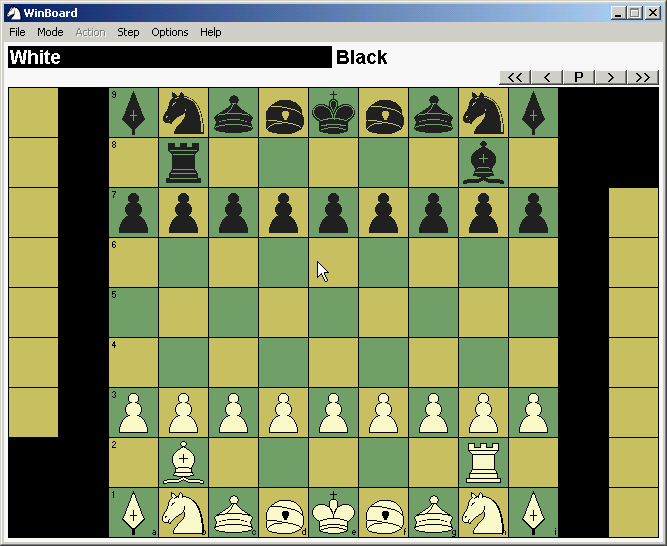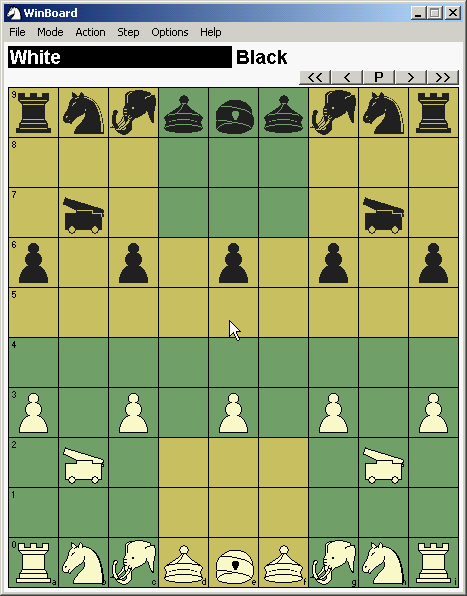Comments/Ratings for a Single Item
 Anonymous wrote on Wed, Jun 30, 2010 12:47 PM UTC:
Anonymous wrote on Wed, Jun 30, 2010 12:47 PM UTC:Shogi is very clever, difficult and philosophical game. Looks like, it have much oriental wisdom in it! Xiang-qi is more lively, simple, and, maybe, childish. Wstern players are better to start with Xiang-qi: it have simpllier rules and, plus, may be played with western chess equipment with some additions.
It's not surprising that the idea of Shogi with a deployment stage has appeared before. Interestring to note how Unachess has several options for a FIDE set and board but only one for a Shogi set and board. What Unashogi lacks is my proposal that Kings must be placed first, a rule that leads into a theoretically possible Shogi position (although in reality players would be unlikely to hold all there captives in Reserve for so long) so that thereafter Shogi rules can apply as standard. As I write a further thought has occurred to me. The Unachess principle could be used for deploying a set on a board for which it was not designed - a FIDE set on a Shogi board, a Carrera/Bird/Capablanca set on a Xiang Qi board, a Chaturanga set on a Diana/Haynie's Primary/Los Alamos board, et cetera. Of course deploying a Shogi set on a board with more or fewer than 9 ranks would require a definition of the promotion zone, likewise the River and Fortress for a Xiang Qi set.
In response to Charles Gilman's comment. What do you think about this game: in additional to normal game (FIDE chess or any other game) there is set with pieces of aproximately same value (the simpliest is set of different compounds of ferz, wazir, alfil, dababa: guard, alibaba, modern alfil, modern dababa, phoenix and kyryn, and, optonally, FIDE chess knight). Each player secretly choses 2 of these pieces (possible to chose 2 pieces of same kind) and can drop them during any turn, opponent don't know, wich pieces player choses until they are dropped.
I'm interested in doing Tsumi problems, but the graphics typically used for them are a stumbling block for me. Not only do they use Japanese characters, but don't include the Shogi piece outlines whose orientation would indicate which side each piece belongs to. Also, the Japanese characters are sometimes small and hard to discern. So that I can more easily do them without straining my eyes, and so that I can actually move the pieces instead of trying to do them in my head, I will begin here to transcribe Shogi Tsumi into Game Courier format and post links here, eventually planning to compile them into their own page. I will begin with the problems in Fat Bold Cyclop's collection of 300 Tsumi problems.
[Edit:] I have fixed the Tsumi to give White all remaining pieces in hand. This was not visible in the diagram, but it is understood as part of a Tsumi that White has all remaining pieces in hand.
 H. G. Muller wrote on Sat, Nov 20, 2010 10:24 AM UTC:
H. G. Muller wrote on Sat, Nov 20, 2010 10:24 AM UTC:I always use the WinBoard GUI for that purpose. It supports a completely westernized (Chess like) representation of the Shogi board. I can simply set up the position in Edit-Position mode, by clicking the squares and selecting a piece to go on it from the context menu that then appears. If the tsume problems would have been given in FEN format, you could of course have directly copy-pasted them into WinBoard. But alas, Shogi people seem to hate standardization, and hardly ever use FEN.
It would be very useful if the web pages you are building would contain the problem in FEN (or EPD) format, so that all standard Shogi software could process it.

And WinBoard supports both its own native WB protocol, as well as USI protocol, so there are many engines (from the weak GNU Shogi to the extremely strong Bonanza) that you could use to analyze positions.
Can you do the same with your Xiangqi program? /Mats
 H. G. Muller wrote on Sat, Nov 20, 2010 05:51 PM UTC:
H. G. Muller wrote on Sat, Nov 20, 2010 05:51 PM UTC:> Can you do the same with your Xiangqi program? <\p>
Of course. WinBoard also supports Xiangqi. You can use the menus to switch from one varant to the other, be it orthoChess, Xiangqi, Shogi, Makruk, Capablanca, Knightmate. They all draw on a built-in set of bitmaps for 2x22 different piece types, but the user can define his own graphicrepresentation of the pieces, if he want. (E.g. to implement a high-quality oriental-style display.) All features are available from all variants.

For all variants there are engines available. E.g. the WinBoard binary download currently at http://hgm.nubati.net/WinBoard-4.5.beta.zip contains a Shogi engine, 3 Xiangqi engines, a strong orthoChess engine, and Fairy-Max, wich plays some 10 other variants.
How nice. I am surprised at the scarcity of good Xiangqi programs, in view of the fact that it's the most popular game in the world. I downloaded Stoneman, but it could not take back moves, due to some bug. I tested a cheaper version, but it played the same theoretical moves all the time. It seems the only good alternative is XieXie, but it has no analysis window. I tested my own Zillions implementation against freeware QianHong, but Zillions won. I also tested the freeware HiddenLynx, but Zillions won easily. I'll have a look at WinBoard. /Mats
I get 'Variant Xiangqi not supported by Fairy-Max 4.8P' /Mats
Ok, I downloaded version 4.4 instead, then it works. /Mats
I noted that Seirawan Chess is implemented in the latest version. If it's patented then it could mean trouble. /Mats
 H. G. Muller wrote on Sat, Nov 20, 2010 10:56 PM UTC:
H. G. Muller wrote on Sat, Nov 20, 2010 10:56 PM UTC:Xiangqi is so different from any other variant (because of the board zoning and King-facing rule) that I made a dedicated derivative of Fairy-Max for it, called MaxQi. The additions required to implement it were not generally useful. (Similarly, there is a dedicated version for Shatranj applying the baring rule, ShaMax, although that is so similar to the original Fairy-Max that it is generated from the same source code, using a compiler switch.) So in the 4.5.beta package you should not select Fairy-Max but MaxQi from the startup dialog engine combobox if you want to play Xiangqi. (And HaQiKi D or Elephant Eye if you want a tougher opponent, or do analysis. MaxQi is derived from an older version of Fairy-Max that did not print a full PV yet.) The 4.4 install does use MaxQi. Qianhong is an extremely weak (non-searching) AI. There are Qianhong plugins that are tougher. VSCCP is the next weakest, and might stil lose to Zillions too. But Elephant Eye is also available as a Qianhong Plugin.(Or rather, there exists a UCCI2QH adapter, from which I actually derived the UCCI2WB adapter.) For an overview of Xiangqi engines that you could run under WinBoard, see http://home.hccnet.nl/h.g.muller/XQ.html and links therein. I asked on the Seirawan website if it was patented, or if it was allowed to support it in WinBoard. Bruce Harper answered me 'Go ahead, the more exposure we get, the better'.
Here's the second Tsumi from Fat Bold Cyclop's collection: FBC Tsumi #2
WinBoard for Xiangqi doesn't allow analysis mode, and I cannot retract moves and make another move, so this software is largely useless as it stands now. /Mats
WinBoard-4.5.beta.zip: In Seirawan Chess I can introduce an external piece to an empty square, which is against the rules.
Another bug: I cannot introduce an external piece to the corner square at castling.
I played a 3 game match between Fairy-Max and Zillions in Seirawan Chess (approx. 10 sec. per move). Zillions is vastly better and won by 2½-½. In game 2 and 3 Fairy-Max blundered away a piece. This must be a bug in the algorithm. Below is game 3. Notice Zillions's remarkable rook sacrifice at the end.
[Event 'Computer Chess Game']
[Site 'DELL-7B4236477D']
[Date '2010.11.21']
[Round '-']
[White 'Fairy-Max 4.8P']
[Black 'Zillions']
[Result '0-1']
[TimeControl '30/600']
[Variant 'seirawan']
[Annotator '1. +0.24']
1. c3 {+0.24/9 53} c5 2. Nf3/H {+0.28/9 17} d6 3. d4 {+0.23/9 16} cxd4 4.
Nxd4 {-0.10/8 17} f5 5. f4 {+0.01/8 14} Nf6 6. Hf3 {+0.13/7 34} e5 7. fxe5
{+0.83/10 15} dxe5 8. Hxe5 {+0.82/9 15} Ng4 9. Bg5 {+0.87/9 44} Qxg5/H 10.
Hf3 {-2.60/10 14} Qf4 11. g3 {-2.33/8 14} Qh6 12. Na3/E {-2.38/8 19} Ne3
13. Qc1 {-2.42/8 27} Nc6 14. Nac2 {-2.37/9 17} Nxc2+ 15. Nxc2 {-2.43/10 15}
Qd6 16. Hh5+ {-2.24/7 14} g6 17. Hf4 {-2.18/9 14} Ne5 18. Bg2 {-2.14/8 24}
Bg7 19. O-O {-2.03/8 28} O-O/E 20. Rd1 {-2.17/7 15} Hb6+ 21. Ne3
{-2.14/7 16} Nf3+ 22. Bxf3 {-2.27/10 21} Qxf4 23. gxf4 {-2.30/10 15} Hxe3+
24. Qxe3 {-2.27/10 16} Exe3 25. Kf2 {-2.15/9 14} Re8 26. h4 {-2.22/8 15}
Bf6 27. h5 {-2.23/8 14} gxh5 28. a3 {-2.96/8 28} h4 29. Rd6 {-2.82/9 14}
Bg7 30. a4 {-2.88/9 13} Kh8 31. Ed2 {-3.03/10 14} Bf8 32. Rd5 {-3.04/10 15}
Bh6 33. Rd4 {-2.94/10 13} h3 34. Rh1 {-2.42/10 14} Bg7 35. Rd8
{-2.38/10 14} Bf6 36. Rxe8+ {-2.25/12 14} Exe8 37. Rxh3 {-2.25/10 15} Eg7
38. e3 {-2.22/8 14} Be6 39. c4 {-2.16/8 17} Rd8 40. Ec2 {-2.30/9 15} Ec7
41. b3 {-2.31/8 15} Ec5 42. Eb4 {-2.33/8 14} a5 43. Ec2 {-3.55/10 15} Exb3
44. Bd5 {-3.56/9 15} Ed3+ 45. Kf3 {-3.55/10 15} Bxd5+ 46. cxd5
{-3.60/10 16} Exd5 47. Eg2 {-3.74/10 14} Rg8 48. Eh2 {-3.77/10 14} Rg7 49.
Ef2 {-3.82/10 15} Ec3 50. Rh5 {-3.77/10 14} Bd4 51. Ee2 {-3.76/11 14} Rg3+
52. Exg3 {-13.29/13 16} Exe3+ 53. Kf2 {-13.36/13 26} Ee4+ 54. Kg2
{-13.38/13 17} Exf4+ 55. Kh2 {-13.99/13 15} Ef2+ 56. Kg1 {-14.00/12 14}
Ee2+ 57. Kf1 {-14.59/13 15} Exg3+ 58. Ke1 {-18.00/12 17} Exh5 59. Kd2
{-79.95/13 14} Ef4 60. Kc2 {-79.95/13 13} Ef2+ 61. Kb1 {-79.96/19 9} Ed2+
62. Kc1 {-79.97/28 6} Ea2+ 63. Kd1 {-79.98/28 4} Be3 64. Ke1 {-79.99/28 5}
Ec1#
{Xboard adjudication: Checkmate} 0-1
/MatsWe, the editors, need a way to move off-topic comments to a different page. The comments here should be about Shogi, not how Winboard plays Xiangqi and and other non-Shogi games. If you want to discuss H. G. Muller's version of Winboard, the Fairy-Max page is a more appropriate place for it.
Sometimes discussions can deviate in another direction. Suggestion: when replying to a person within a category, one could, by notching an alternative, place the comment in an off-topic, or general, category. However, visually, it is placed immediately after the previous comment. /Mats
I've already posted this Tsumi, but this time I'm posting it as a form with the solution included as one of the fields. I'll now work on adding an option to view the solution.
25 comments displayed
Permalink to the exact comments currently displayed.

I have now recorded and uploaded my fourth video in my Shogi for Chess Players series. This one completes my explanation of the rules of Shogi, covering the capturing and dropping of pieces.